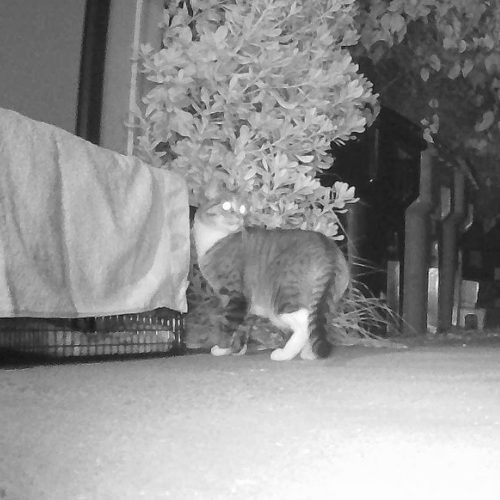
What To Do If Your Cat Goes Missing
First, there are two things you should not do if your cat is missing. Don’t assume your cat knows how to get home, and don’t stop looking for them! Cats can be gone for weeks or months before finding their way home without help.
If your cat runs away or goes missing, start by walking around the house, calling their name, and looking for them. Most indoor-only cats won’t stray more than two houses away, so you can hopefully find them close by and quickly. Cats that are indoor/outdoor are more likely to stray up to one block in either direction, which means you’ll have to expand your search radius.
Look under bushes, decks, under cars, and up in trees. The cat may be scared, so it may not come out or make any noise when called.
Cats are diurnal, so searching at night, dusk, and dawn is a good idea, and the light from a flashlight can reflect off the cat’s eyes in the dark, making them easier to see.
Before you start a serious search, make sure your silly furry friend hasn’t found a new hiding place in your closet. It happens to the best of us.
Cats can be gone for 18-24 hours before you need to worry. At this time, you can begin to take flyers around to all your neighbors and ask if you can look around their yards or an open garage.
Keep your search up, and don’t get discouraged if it takes weeks. In some cases, the longer they are gone, the greater chance they have of being found again.
A lost indoor cat is probably scared and hiding. If the cat has been gone for a few weeks, it may have found a new human that is feeding them. Once the human gets to know the cat, they may search shelters and online for a missing cat.
That’s why it’s important to keep up your search for your furry friend!
Will A Lost Cat Come Back Home On Its Own?
The first thing to consider for what to do if your cat goes missing is if they will come home on their own. A cat has a home instinct that helps them find its way back home, sometimes. However, if your cat is lost during or after moving into a new house, or if the cat is spooked and runs to an unknown location, it may have a hard time finding its way home.
Do not assume the cat will find its way home on their own. Many cats are skittish and get very scared when they go missing. That means that even if they do come home, getting them into the house might be a challenge.
If you find your cat but can’t get them into the house or the cat’s carrier, you might need to set up a cat trap. If your cat is nearby, they are likely in a hiding spot by your house. Setting some food bait and a cat trap might be the easier way to catch most cats.

How To Help Your Cat Find Its Way Home
Usually, if a cat has gone missing, they won’t go far, and they will return on their own because of their homing instinct. Other times, the cat may be scared, cornered, or lost and unable to easily find their way home. Here are a few ways you can help your cat find its way home.
- Remove distractions to allow the cat to come back in the way it left. Put other pets in a bedroom so you can leave the door open to encourage your cat to walk back inside.
- If it’s overnight, leave the window or side door cracked open and place your cat’s favorite bed or a bowl of fresh food nearby.
- Update your microchip info and post an alert on your microchip database. If someone picks up your cat, they are likely to have it scanned by a local vet.
- Make missing cat posters and place them around the neighborhood. Friendly cats may approach neighbors who may begin to feed them. Posters will help make your neighbors your allies.
- Check every animal shelter in the area every 2-3 days for a few months. You can follow them on social media, Petfinder.com, or call them every few days to find your beloved cat.
- Post your missing cat on Facebook Groups, Craigslist, Nextdoor, Whisker Tracker mobile app, Petco Love Lost, and PawBoost.
- Set a trail camera to identify them around your house or smaller territory.
- Lay a trap! Borrow a cat trap from a local cat rescue and see if you get lucky. Put your cat’s favorite food in the trap, and when the cat enters the trap, it will close behind them. Review our tips about how to trap a cat with humane traps.
Where Do Lost Cats Hide?
You may be able to find your missing cat in one of the usual cat hiding places, such as a neighbor’s garage, underneath a car, behind a garbage can, or even up a tree. Missing cats are usually scared because they are away from their home territory. Be aware of very faint meows or paw prints, and call out to your kitty multiple times before checking a new location and conducting a thorough search.

How To Catch A Scared Cat
If your lost feline friend is frightened, and it probably is, then you’ll want to try some of these techniques to help your kitty stay calm and let you catch them. It’s a good idea to bring a cat carrier when you look for a lost pet. You can also bring their favorite food and treats to lure them into their carrier.
When approaching a scared cat, always keep your movements slow and speak in a soft, calm voice as you attempt to approach them. Try to get them to come to you first, and only approach patiently not to startle them further. It’s ok to sit there for several minutes while your cat calms down.
Here are a few tips for catching a scared cat with a trap.
How To Do Community Outreach For A Missing Pet
Community outreach is one of the best ways for cat owners to find missing cats and get their cat quickly home. Print lost cat posters and place them at popular locations like gates, signposts, and fences or walls. Sometimes, you can slip a note with your contact details in mailboxes or on a neighbor’s door if you think the cat may be on their property.
The posters should include your name, contact information, a current picture of your cat, and a brief pet description, including your cat’s personality.
You can also expand beyond your local area and post flyers or send emails to animal shelters, local vets, animal control, or even local police. You can even contact your local newspaper about your cat’s disappearance. Those are all places where a pet owner may call for found animals.

Don’t forget to post your lost cat on Craigslist, Nextdoor, Whisker Tracker, and PawBoost.com.
Social Media For Missing Pets
In addition to community outreach and posting on Nextdoor, social media is a great way to get the word out about missing pets. Every area usually has several Facebook Groups that can help you find missing indoor cats. Animal lovers who manage these groups can also help connect you with local shelters that might be able to provide additional support with a physical search for your cat.

Missing Pets Apps
There are several mobile apps available specifically for lost and found pets, such as Whisker Tracker, PawBoost, and Petco Love Lost. Some of these apps use facial recognition technology to match photos of your pet with those uploaded by other users who have found a stray animal. You can also post on social media apps like Facebook or Nextdoor, which have dedicated groups for lost and found pets in local communities. Make sure to check the apps often for responses or activate the push notification feature to receive immediate responses for lost or found pets.
Microchipping Cats
A microchip refers to a tiny computerized GPS chip placed underneath a cat’s skin. A microchip is usually placed around the shoulder, and its primary function is to act as a form of identification. If it’s lost, it is easy to locate your cat because the microchip gives location coordinates. Microchipping should be done by a veterinarian who is well-versed and experienced in the field.
Why It’s Essential To Keep Cats Indoors
The benefits of keeping your cat 100% indoors outweigh the cost. Although some feline owners feel guilty about keeping their cats indoors, worrying that they are depriving them of fresh air, sunshine, and exploration, it is okay. Indoor cats are safer, happier, and experience fewer risks, unlike outdoor cats.
Outdoor cats can be introduced to dangerous health concerns from other cats or other animals and unsafe and unclean environments. Here are a few things you can avoid by keeping your cat indoors.
- Feline AIDS (FIV)
- Feline leukemia (FeLV)
- Distemper
- Upper respiratory infections
When your cat is venturing outside, it can pick up fleas and other parasites, including:
- Ticks
- Ringworms
- Intestinal worms
- Ear mites
Conclusion
Losing a cat is an incredibly stressful experience, but with the right strategy and perseverance, you may be able to find your missing pet. Don’t think about the worst-case scenario! Stay positive and take action.
Whether it’s putting up posters around the neighborhood, asking for help online, or even checking animal shelters in the area every few days, there are many effective ways of searching for a missing cat.
It also pays off to think about where cats usually hide when scared, such as garages and underneath cars, and try luring them out with their favorite treats. Finally, always make sure that your cat’s microchip information is updated so that if they do get lost, then you can easily identify them upon discovery.
We hope this article has been helpful in finding your missing feline friend!



